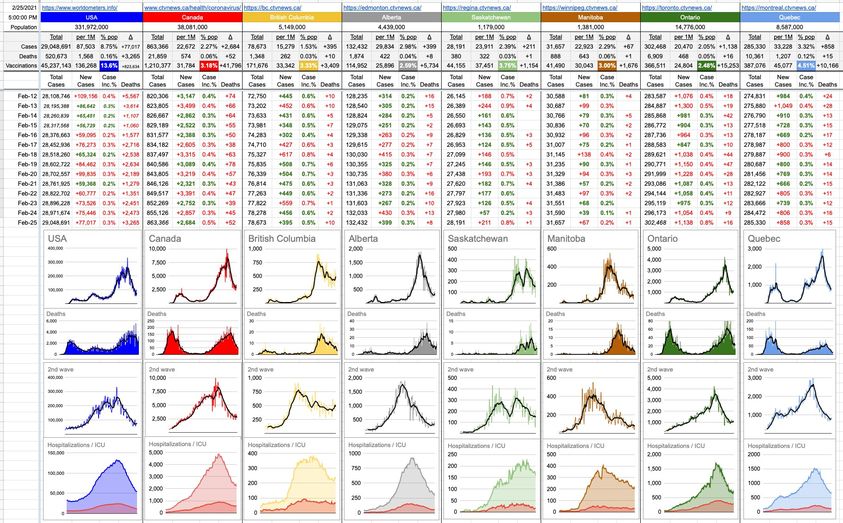September 20, 2021
Where to start.
Well, it’s election day… if you can, go vote… an awful lot of people in the past gave their lives to offer you the right to vote in a democratic process; something, clearly, that gets taken for granted around here – a fact that becomes very obvious when people start screaming about their rights being taken away from them. To summarize what I wrote about last time… your right to vote is indeed one that, if it were taken away, would be worth complaining about. Your unilateral and thoughtless and stupid decision that’s preventing you from entering your favourite restaurant… isn’t. So, go exercise your actual freedom and right to vote, and if you’d rather not because “they all suck”, keep in mind that not voting is itself a vote – a vote for the status quo. If you want to see some change, go be part of it.
And what exactly has that status quo brought us? Let’s rewind 18 months or so to the start of this pandemic… to the time where we were all freaking out at the single-day case numbers which were really not that high… but we had good reason to freak out. Because in other places around the world – remember Italy and Spain? — things got out of hand very quickly; that’s what happens with exponential growth and when things hit the tipping point.
The horror of what was going on: Hospitals swarmed with cases, packed to capacity. People dying in the corridors. People dying in the parking lot because they couldn’t even make it inside. ER doctors having to make decisions that will haunt them for the rest of their lives: You get to live. You get to die. Come on in; you’re welcome. Sorry… really sorry. Go home. Good luck.
We watched in horror. We hoped whatever the hell our leaders were doing around here, it’d be enough to prevent that from happening locally. Just in case, emergency beds were prepped, among them the 271-bed $2M hospital that was created at the Convention Centre. We hoped it’d never get used (and it never did), but it wasn’t till earlier this year that it was all dismantled for good. So many unknowns.
As time went on and more understanding came to light… the cause, how it spreads, effective treatments and eventually, of course, vaccines, the chances of it spiraling out of control around here diminished. We made it. Phew.
Which is why it’s actually unbelievable what’s going on in Alberta right now. Like, truly. Of all of the possible outcomes, is there any reasonable person who could’ve foreseen this? That 18 months after a few very unlucky places got the crap kicked out of them (and, in hindsight, there was little they could’ve done), that here, in Canada, with first-world medical care, a year and half of history and knowledge, effective treatments and vaccines… we’re at this point? Mind-boggling doesn’t even begin to describe it. I look at the hospitalization / ICU graph below and, honestly, it’s hard to believe. Or is it.
The thing with living day-to-day is that things creep up on you slowly… it’s just one small evolutionary step from yesterday… changes so subtle you don’t notice them and you don’t even think about it… but that sort of short-sighted thinking has no place at any higher level of responsible planning. Pandering to the crowd “today”, for a short-term “gain”, should never be a part of it. At an individual level, every single day, the news has multiple examples of people whose thought process over time went something like this: It’s no big deal, it’s just a flu, I’m young and healthy, I can take care of myself, I don’t trust vaccines, I’m not feeling well, I’m getting checked out just in case, it turns out I have Covid, I’m having trouble breathing, they’re putting me on a ventilator, pray for me. Then a final update from a friend with a GoFundMe link because funerals are expensive, you know, and they left behind a family who’s now pleading to everyone around them to get vaccinated.
But that’s one individual. Actually, unfortunately, many individuals. At ground-level, that’s how it looks.
But from 30,000 feet in the air, looking down at the big picture, to allow a province in Canada to reach this point? It’s not like it crept up on anyone. It’s not like you couldn’t see it coming. It’s not like the world hasn’t been offering numerous, comprehensive examples of exactly how to (and how not to) do things. They didn’t see it coming? Where were they looking?
Perhaps the only thing they saw coming was an election… and that’s relevant because it reminds us all… that we, the innocent people, think that those in charge have our best interests at heart. Don’t get me wrong… in a way, they all do, or at least think they do. But that sentiment is in second place. In first place is a very clear mandate; get elected. Stay elected. Do and say whatever the hell you need to… just get in and stay in.
We have our own little version of Red State / Blue State up here. Alberta, aka Texas of the North, is now facing a potentially catastrophic situation and they have absolutely nobody but themselves to blame.
I think we’re all reminded of the story of the squirrel or a beaver or ant or whatever creature it is that mocks everyone in the summer who’s busy squirreling away nuts for the winter (ok, I guess it’s a squirrel). Who has time to worry about it when the sun is out and there’s fun to be had? Then winter rolls around and the squirrel is starving and cold while all the others are warm and happily being fed from their vast supplies.
I don’t remember in the story whether some other squirrel comes to the rescue or whether the short-sighted squirrel is left to die, but I can tell you that around here, there are no spare ICU beds. There are probably enough to cover our local freedom-seeking non-vaccinated Covidiots, but that’s about it.
Next to oil, Alberta may soon be exporting Covid patients, though to where remains to be seen. It’s sad and pathetic, and as fellow Canadians, they deserve a lot better than that.












